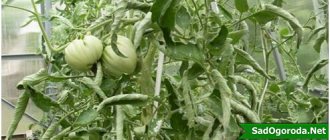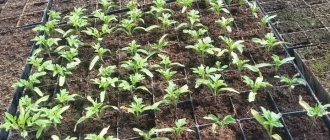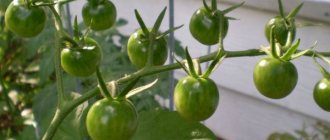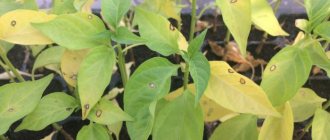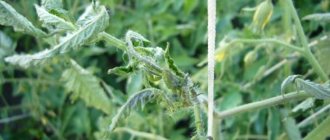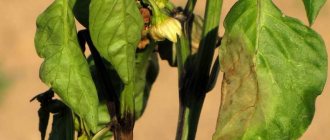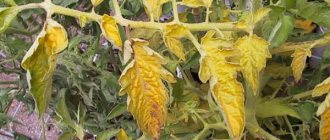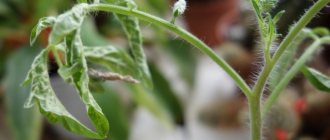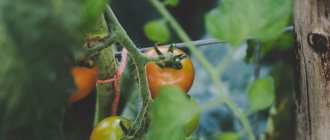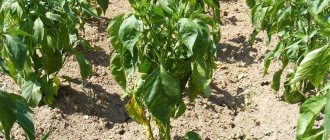Tomatoes are a rather fastidious crop, and to get a good harvest, constant care and close attention are required. And it seems that you are observing all the conditions for planting and care, and the leaves on the tomatoes begin to curl up. And it starts to bother you, because you understand that it shouldn’t be like this. Apparently, when caring for tomatoes, mistakes are made, as a result of which the tomato leaves curl. What to do, how to deal with this and correct mistakes? Of course, first of all it is necessary to find out the reason.
If the lowest seven-lobed leaves curl, then there is no need to worry. The curled leaves will soon fall off, followed by growth of true permanent leaves. But if permanent large leaves curl, then you need to look for the reason.
Curling of leaves may be a varietal characteristic of tomatoes. Therefore, when purchasing seeds, carefully read the description of the characteristics of the variety in order to avoid worries later. Well, if this is not the problem, then look for other reasons, which I will discuss later in the article.
Deviations from the thermal regime
Temperature fluctuations are the main reason why tomato leaves curl and dry in a greenhouse. Exorbitant temperatures in the greenhouse and hot, sultry weather when cultivating tomatoes in the garden are extremely unfavorable phenomena.
Important! The optimal temperature for greenhouse tomatoes is +22 degrees during the day and +18 degrees at night.
Temperatures above +30 degrees put plants under stress. To reduce the evaporation of precious moisture, tomato leaves are rolled into a tube. With the onset of twilight they spread out again.
To eliminate this reason for healthy tomato leaves curling in a greenhouse, you need to:
- open doors, transoms;
- whitewash the roof with chalk;
- curtain with a special fabric.
In extreme heat, garden tomato beds can be shaded and the tomatoes can be fed with nitroammophos at the rate of 20 g per 1 m², having previously dissolved the fertilizer in water.
You also need to water the tomatoes so that they do not curl with increased water in the morning or evening hours. The row spacing should be mulched with straw (sawdust).
If the heat in the greenhouse causes the leaves to curl inward, you can try spraying the plantings with a urea solution prepared according to the following recipe:
- urea – 2 tbsp. l.;
- water – 10 l;
- consumption of the prepared liquid – for 10 bushes.
After waiting a few days, it is recommended to re-treat the tomatoes against leaf curl with potassium sulfate, dissolving 10 g in 10 liters of water. This solution is enough for 10-11 bushes.
Tomato diseases
When diseases appear in tomatoes, not only do the leaves curl, but other symptoms also appear. It is important to identify the lesion in time and begin treatment. In some cases, diseased bushes cannot be saved.
Bacterial cancer
The disease is caused by bacteria that affect the vascular system of tomatoes. As a result, the plants' leaves curl, dark spots appear, and ulcers are visible on the shoots. Brown stripes can be seen on the cut of the stem. The fruits become covered with white spots and become unfit for consumption.
Bacterial canker spreads in a greenhouse at high temperatures and humidity. Thickened plantings overgrown with weeds are at risk. Affected bushes cannot be cured. They are dug up and destroyed. To disinfect the greenhouse, a smoke sulfur bomb is used.
Tobacco mosaic
The disease is viral in nature and spreads through soil, seeds or pests. The first sign is the appearance of light spots on the tops. Over time, the lower leaves of tomatoes in the greenhouse curl, and the damage spreads to the top of the bush. The plant dries out, the pulp of the fruit rots and turns black.
At the first signs of tobacco mosaic, tomatoes are treated with Karbofos and Maxim. If the lesion covers the entire bush, it will have to be dug up and destroyed. The soil in the greenhouse is completely replaced or disinfected.
Fusarium
The disease is caused by a harmful fungus. The first symptoms appear during the flowering period. The process starts from the bottom of the leaves. They lose turgor, become pale green and curl. Over time, the tops dry out and the tops acquire an anthocyanin color.
Fusarium spreads during drought. The disease affects weakened bushes that receive few nutrients. The source of infection is soil, plant residues, and planting material.
It is better to fight fusarium in the early stages. To treat leaf curl, tomatoes in the greenhouse are treated with Trichoderm. This is a biological product that contains fungi that are beneficial to plants. They suppress the activity of harmful microorganisms, disinfect the soil, and have a healing effect.
Verticillium wilt
The disease is caused by a harmful fungus. When infected in a greenhouse, tomato leaves curl down, turn yellow and wither. In the early stages, Verticillium wilt is identified by chlorotic spots on the tops. If you cut the stem, you can clearly see the brown vessels. With severe damage, the disease reaches the top of the tomatoes.
On tomatoes, the disease more often appears in greenhouses. Pathogens persist in soil and plant debris. They are active at high humidity and temperature. The disease spreads quickly in soils poor in organic matter.
An effective treatment for verticillium has not yet been created. Prevention will help to avoid damage: disinfecting the soil before planting, observing crop rotation.
Attention! Many modern tomato varieties are immune to verticillium.
Bacteriosis
Tomato bacteriosis appears in hot and humid weather. Bacteria penetrate the plant's vascular system. Symptoms of the lesion do not appear on the bushes for a long time. However, a mucous mass is released on the shoot sections. Gradually, the tomato tops begin to turn yellow and curl. The bush stops developing and does not bear fruit.
To treat bacteriosis, tomatoes are treated with Fitolavin. Its active substance penetrates plant tissue and improves their immunity. Healthy bushes are also sprayed to avoid infection. If the disease spreads quickly, you will have to completely remove the bushes from the area.
Acute moisture deficiency
A common reason why the leaves of tomato seedlings curl up in a boat is a lack of moisture. It is recommended to water tomatoes abundantly and regularly, without long breaks.
A high need for moisture in tomatoes occurs after planting seedlings in garden beds or in a greenhouse. At this point, it is advisable to pour 4 liters of liquid onto each bush. After waiting 10 days, it is recommended to re-water, increasing the watering rate by 50%.
The following is based on the weather:
- if it’s hot and the tomatoes are slightly wilted, you need to water them twice a week;
- in cool weather, 1 irrigation per week is sufficient.
When the ovaries begin to form, the watering rate is increased by 1/3.
Experiencing a moisture deficit, the tomato begins to reduce the proportion of evaporated moisture and the leaves of the plant curl inward. Having noticed this, you should immediately start watering.
Photo. Tomatoes suffering from moisture deficiency
Errors during landing
Leaf curling both inward and upward, leading to a decrease in yield or its complete loss, can be caused by mistakes made by gardeners during planting and cultivation. Before purchasing seeds, you need to decide on the place where future tomatoes will grow. When choosing a variety, we start from its characteristics. If this is a greenhouse, then it is more advisable to purchase interdeterminate varieties, famous for their tall bushes up to 5 meters. For open ground, determinate bushes are suitable, which, with low growth, can produce a bountiful harvest. Street sudden changes in temperature or greenhouse high humidity for a particular variety can cause death.
Many people mistakenly believe that a large amount of moisture or water will only benefit the plant. But this is far from true. Excess moisture, as well as excess light, lead to various ailments or the appearance of insects. Watering should be rare but plentiful. Excess sun is easily determined by curled sheets, which are always straightened in the evening.
You should not plant seedlings with inflorescences, as they will take all the energy of the plant, not allowing it to take root. A weak root system is the key to plant death, which first manifests itself in leaf curling. If for any reason you were unable to transplant the plant into open ground in a timely manner, and inflorescences have already begun to appear on it, then they must be removed before planting. After which we place the seedlings in a hole with a sufficient amount of water.
If your tomatoes are varieties that require the mandatory formation of a bush, then the main thing here is not to overdo it with the removal of excess leaves. This can also cause the death of the plant, which will begin to manifest itself in curling of the foliage. It is advisable to start pinching when your plant has reached a height of five centimeters.
Lack of soil nutrition elements
The next reason why the leaves of tomato seedlings wither and curl is a lack of certain nutrients. Due to a lack of certain elements, the upper or lower leaves of the plant curl up or down; let’s look at how to deal with this deviation.
Phosphorus deficiency
With a small amount of phosphorus, the leaves curl upward, and the underside of the leaf blade turns purple. This disease can be cured by applying superphosphate under tomato bushes. Do the following work:
- 150 g of superphosphate pour 1 liter of boiling water;
- leave the composition for 20 hours;
- Dilute the extract with 10 liters of water;
- Water the resulting solution at the rate of 500 ml under the tomato bush.
Important! You can limit yourself to adding dry ash under the bushes, then you will have to wait a week longer for the result.
Copper deficiency
Copper is important in growing tomatoes. Copper deficiency is less common than others, especially when bushes are treated with Bordeaux mixture against fungal diseases.
Symptoms of copper deficiency:
- the edges of the leaves curl up;
- random blurry yellow spots appear on the leaf blade;
- then the tomato leaves turn black and die, as shown.
How to save the plant in this case? Experienced gardeners recommend spraying the bushes with any copper-containing preparation.
Important! Using this method, you can compensate for copper deficiency and protect tomato bushes from a number of diseases.
Little potassium in the soil
If the leaves curl up into a tube, a brown border appears along their edges - this is a symptom of a lack of potassium for nutrition. Treatment for such twisting is carried out by applying potassium fertilizer.
Potassium nitrate contains potassium and some nitrogen.
The solution is prepared and added as follows:
- dilute 1 tbsp. l. saltpeter in 10 liters of water;
- stir until completely dissolved;
- water, spending 500 ml for each bush.
Adherents of folk remedies for combating tomato diseases can treat with ash extract according to the following recipe:
- Pour boiling water over 100 g of ash;
- leave the composition for a day;
- every 2 hours the solution must be stirred;
- strain the solution;
- water the tomatoes at the root level at the rate of 500 ml per bush.
Important! You can spray tomato bushes with an ash solution; for better adhesion, it is advisable to add 30 g of soap to the composition.
Nitrogen deficiency
Nitrogen starvation occurs on depleted soils and when technology requirements are neglected. If there is insufficient nitrogen, the plant develops a yellow tint and the upper leaves become smaller.
When the leaves begin to lighten and curl downward, the tomatoes are experiencing severe nitrogen starvation. Then the leaves become yellow and dry out.
It is urgent to apply nitrogen fertilizer. Nitrogen starvation can be stopped by watering the bushes with herbal infusion.
Small proportion of calcium in the soil
The calcium type of starvation causes the leaf blade to curl upward, and the fruits are affected by blossom end rot.
How to feed tomatoes in such a situation? Vegetable growers use the following recipe:
- calcium nitrate – 21 g;
- ash – 380 g;
- urea – 11 g.
Important! All ingredients are diluted in a bucket of water, mixed and the solution is used for root feeding. One bucket is enough for 4 m² of plantings.
Aphid damage
Identify the problem in a timely manner Most often, when the leaves are already crowded and deformed, aphid damage reaches a large scale. Turning the leaf over, you can find many small insects. The sooner you start fighting, the better
Another important note: most often aphids are brought by ants, so destroy all anthills on the site, regardless of whether they bother you or not. This significantly reduces the likelihood of aphids appearing
Treat with chemicals
')); (w||(w=[]))&&w.push({id:b,block:'14502'});})(window,document,"mtzBlocks");
The most effective and efficient option
Suitable for significant plant damage and works quickly. But after such preparations, tomatoes cannot be harvested for 2-3 weeks. If the work is carried out during the fruiting period, it is better to remove all brown tomatoes and let them ripen indoors. Use proven medications. Well proven: Iskra, Akarin, Biotlin. There may be other options, if there are none in your region, it is better to consult with experienced gardeners, they will suggest effective solutions
Use biological preparations Their main advantage is that tomatoes can be harvested within two days after treatment. The effectiveness is lower than that of chemical options, but it is enough for medium-scale damage. It is best to use Fitoverm and Actofit. Remember that the drugs act normally at temperatures from +16 to +25
Use folk remedies Pour 2 liters of sifted ash into 2 liters of water. Boil and leave to steep for at least a day. Strain and dilute with warm clean water in a ratio of 1:10. Add 100 g of liquid soap to the bucket, mix well. Treat plants in the evening. Try to cover both the top and bottom of the leaves.
Cultivate the soil forever. For prevention, use the drug Fufanon. Dilute it according to the instructions. Water the soil in the evening. This is an excellent prevention against most pests.
Excessive nutrient content
Some summer residents, in pursuit of high yields, apply a lot of mineral fertilizers. As a result, the leaves dry out and turn yellow, not because the plants lack something, but because of the application of excess fertilizers. Let's see what happens to tomatoes that are overfed with nutrients.
Excess nitrogen
If the soil contains an excess amount of nitrogen, the tops of the tomatoes curl, but the remaining leaves look quite normal.
Elimination of the problem: to correct the situation, immediately stop nitrogen fertilizing. To neutralize the effects of nitrogen, add potassium sulfate or ash extract to the soil.
Excessive amount of zinc
With excess zinc content, tomato leaves curl upward, and it may seem that the bushes do not have enough moisture. However, on the lower tier of the tomato bush, a secondary symptom of zinc overfeeding occurs - a purple color on the leaves and stems.
Elimination of the problem: you need to stop fertilizing and add organic matter.
Lots of manganese in the soil
If there is too much manganese in the soil, the leaves first curl, then become corrugated and turn bright green.
Elimination of the problem: you should stop feeding tomatoes with microelements.
Microelement imbalance
Deficiencies and excesses of microelements are immediately reflected in the appearance of tomatoes:
- with an excess of zinc, the leaves become purple and curl;
- with a lack of phosphorus, they turn gray and become deformed;
- when there is a lot of manganese in the soil, the color of the plants is bright green, deformations of the edge and middle of the leaf are observed;
Calcium deficiency is often accompanied by changes in the edge of the leaf blade and superficial mold damage to the fruit;
- excess nitrogen is characterized by massive growth of leaves; at the top they straighten out worse and remain compressed for a long time;
- copper deficiency is manifested by yellowing and then blackening of curling leaves.
Mechanical root injuries
After placing young seedlings in a permanent place, their leaves curl a little; this should not frighten the vegetable grower. In a week the bushes will look quite normal. If recovery does not occur, then the bushes should be treated with stimulating drugs.
Sometimes vegetable growers injure the roots when weeding and loosening tomatoes. As a result, the leaf plates curl upward along the entire length of the bush. To support the plants, you need to water the tomatoes so that they do not curl with a stimulating drug:
- Kornevin;
- Epin Extra;
- Cornerost;
- Zircon.
Violation of pinching technology
The leaves at the top of the bush and in its central part curl due to improper execution of the pinching procedure. Stepchildren grow from each leaf axil; they should be removed by breaking them off at a length of 5 cm. When the formation of bushes is delayed and the stepsons are broken out late, leaf curling begins.
Important! If overgrown stepsons have been removed and the tomato leaves have curled, you should spray the bushes with Zircon.
Bright sun rays (hot weather)
If tomatoes grow in an open, sunny place, many people try to water more often in hot weather. But this will not save the situation. Frequent watering can cause the roots of tomatoes to simply cook; moderate watering can cause the leaves to curl. Watering by sprinkling (from a watering can) is strictly not recommended. If you do this during the day, the leaves will get burned from the water droplets, which act as miniature lenses. By watering in the morning or evening, plants can be affected by late blight.
The best option is to organize drip irrigation. In this case, the plants will receive enough moisture, and it will go directly to the roots, and at the same time the roots will not suffocate due to lack of air.
Pest exposure
Pests also cause damaged leaves of tomatoes to curl in greenhouses and open ground. Below are the most harmful insects that damage leaves.
Whitefly
This small white butterfly is a serious pest of greenhouse tomatoes. The butterfly and its larvae drink tomato juice, secreting sweet honeydew. This sticky mass is colonized by sooty fungus. As a result, the leaves curl into a tube and the tomatoes turn black, which leads to a significant loss of yield.
In case of focal spread of the pest, Fitoverm is used. If the spread of butterflies has become widespread, carry out 3 treatments at weekly intervals with Aktara.
Aphid
It is mainly garden tomatoes that suffer from the effects of aphids. The insect sucks the sap, causing the upper leaves to curl.
To destroy aphids, the following means are used:
- Spark;
- Proteus;
- Aktara.
Spider mite
This pest is classified as sucking. As a result of the influence of the mite, the leaves of tomatoes in the greenhouse begin to curl and dry out.
You can control the number of ticks using acaricidal agents:
- Flumaita;
- Borneo;
- Oberon.
Excess fertilizer
Excess fertilizer can also have a negative effect on tomatoes.
An excess of manure, especially fresh manure, or fertilizing with liquids or herbal infusions that are not diluted sufficiently with water, leads to the fact that the plant cannot absorb a large amount of nutrients. Leaf photosynthesis decreases and leaves curl.
The fumes and ammonia released from them lead to burns, and from them the leaves also curl and die. Therefore, when feeding tomatoes, stick to the golden mean, follow the dosage when applying solutions.
Diseases of culture
Diseases are also the cause of leaves curling in tomatoes growing in greenhouses and open ground.
| Name of the disease | Symptoms | Control measures |
| Stolbur |
| The effect is achieved by treatment with Phytoplasmin. |
| Bacterial cancer |
|
|
Important! When treating for cancer, try to completely wet all the leaves with the chemical. It is advisable to wet the soil surface as well.
Gardening tips
When placing tomatoes in a greenhouse, you should maintain a distance of 40-70 cm between plants. The layout of the beds depends on the shape of the plant. If the tomatoes form into 1 stem, the bushes are planted more densely; if they form 2-3 stems, they are placed more spaciously.
In the process of caring for plants, all leaves below the fruit clusters are removed. These leaves are no longer beneficial for the plant.
Important! Good air circulation in the greenhouse is the key to healthy plants.
When removing shoots from a tomato, leave a stump 1 cm long. The stump will prevent new shoots from forming in this place.
Plants should be watered and fed by watering at the roots, without soaking the tops (with the exception of foliar feeding with microelements or treatment against diseases). Irrigation water should be warm.

